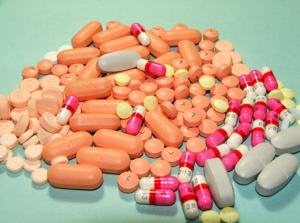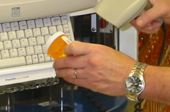 Three years ago, Carol Steckel, Alabama’s Medicaid director, sent a national alert to all of her counterparts around the country. She asked them to join her in uncovering fraudulent prices published by major drug makers — prices that she said inflated the amount all states were paying to pharmacies.
Three years ago, Carol Steckel, Alabama’s Medicaid director, sent a national alert to all of her counterparts around the country. She asked them to join her in uncovering fraudulent prices published by major drug makers — prices that she said inflated the amount all states were paying to pharmacies.
At the time, Alabama had won three lawsuits against drug manufacturers on the grounds that published prices were artificially high. Steckel was working on an entirely new way to set drug prices for Medicaid beneficiaries, one that aimed to lower Alabama’s overall costs, but also remain sensitive to the needs of local pharmacies to make a profit.
Last September, Alabama won federal approval for the change Steckel sought. Since then, the state has launched its new pricing method, and expects to shave 6 percent off its prescription drug bill this year.
In January, Oregon received federal approval to do the same thing.
Now, the U.S. Department of Health and Human Services is urging other states to add Alabama’s pricing model to their toolbox of methods to cut Medicaid costs. Last week, the federal agency announced it had hired a contractor to build a national drug pricing database that would help other states use the same strategy Alabama is employing.
The fiscal crisis states have been facing runs so deep that they have no choice but to look for savings wherever they can find them. According to a survey by the Henry J. Kaiser Family Foundation, every state is taking steps to curb payments to pharmacies. Those payments account for about 10 percent of all Medicaid spending, or roughly $37 billion a year out of state budgets.
A decade ago, states began pushing cheaper generic medicines for their Medicaid populations as a way to curb what was a small but fast-growing slice of their budgets. And it worked: Drug costs aren’t rising as steeply now.
Using Alabama Model to Crack Down on Inflated Drug Prices
Nearly all states base their drug prices on the wholesale prices published by manufacturers. This method is called the “average wholesale price,” and it’s the benchmark states have used for decades to figure out what to pay pharmacies dispensing drugs to Medicaid beneficiaries.
Alabama decided to verify that the prices pharmacies pay for drugs actually were what the drug companies said they were. What it found was that pharmacies typically paid less than the published wholesale price. Not only that, but state Medicaid programs generally pay more than private insurers do. Even among states, prices vary widely for the same name-brand and generic drugs. Court cases in Alabama and elsewhere have generally upheld claims that drug maker price lists were inaccurate.
 Alabama’s new pricing method, known as “average acquisition cost,” is based on what the pharmacies actually pay. To find out that information, Alabama hired a contractor to conduct a twice-yearly random-sample survey of about 350 of the state’s 1,350 drug stores. Over the course of two years, every pharmacy will be sampled. They are asked to hand over one month’s worth of receipts for all of their drug purchases and file updates to those prices weekly. The federal government has hired the same contractor and has committed to a similar survey schedule.
Alabama’s new pricing method, known as “average acquisition cost,” is based on what the pharmacies actually pay. To find out that information, Alabama hired a contractor to conduct a twice-yearly random-sample survey of about 350 of the state’s 1,350 drug stores. Over the course of two years, every pharmacy will be sampled. They are asked to hand over one month’s worth of receipts for all of their drug purchases and file updates to those prices weekly. The federal government has hired the same contractor and has committed to a similar survey schedule.
Pharmacies — particularly small independent ones — had doubts about Alabama’s new pricing scheme because it might squeeze their profit margins. To get pharmacists to support the change, Alabama raised the so-called “dispensing fee” it pays from $5.40 for each prescription to $10.64. “They let their concerns be known and we addressed them,” says Alabama’s pharmacy director, Kelli Littlejohn. “People are surprised that we could cut $30 million and still have the support of all of our pharmacies. It’s strictly because they were engaged from day one.”
Oregon also nearly doubled its dispensing fee when it decided to switch to the new pricing scheme. Any state looking to follow Alabama’s lead would have to. Without higher dispensing fees states will see their network of pharmacies disappear, particularly in rural and low-income urban communities.
States don’t want to squeeze the pharmacies too hard. While they want to keep their drug bills as low as possible, they also must ensure that enough pharmacies survive to supply Medicaid beneficiaries with the drugs they need.
 For brand-name drugs, it’s relatively easy to estimate what pharmacies pay—the prices are listed. But for generics — which now make up more than 80 percent of all drugs dispensed — it’s much more difficult. Generic drugs are a commodity, with prices that vary regionally and fluctuate daily. Multiple drug makers produce generics and they charge different prices to different pharmacists, depending on volume, special promotions and other factors. Without asking drug stores to hand over their receipts, states would have no idea what they’re actually paying.
For brand-name drugs, it’s relatively easy to estimate what pharmacies pay—the prices are listed. But for generics — which now make up more than 80 percent of all drugs dispensed — it’s much more difficult. Generic drugs are a commodity, with prices that vary regionally and fluctuate daily. Multiple drug makers produce generics and they charge different prices to different pharmacists, depending on volume, special promotions and other factors. Without asking drug stores to hand over their receipts, states would have no idea what they’re actually paying.
The effort put into developing the Alabama program — plus the $170,000 per year the state pays the contractor to look at pharmacy receipts — is a small price to pay for $30 million in savings.
The next step for Alabama is a voluntary program in which community pharmacies will get an extra fee starting January 1 for dispensing a 90-day supply of certain drugs; currently, there’s a monthly limit. The change is designed to cut costs by allowing bulk purchases and make it easier for patients to keep taking their prescribed medicines. Together, Alabama’s Medicaid agency expects the programs to not only save about $9 million, but also improve outcomes for patients.
(First published in Stateline.org)



















